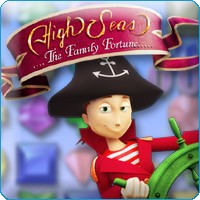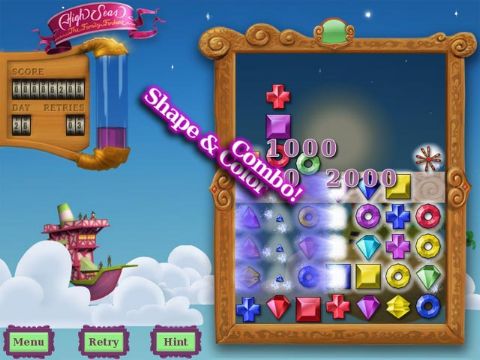High Seas – The Family Fortune
I am happy to announce my secret side project: High Seas – The Family Fortune.
It is our attempt at making a fairly innovative yet accessible casual game.
From the Press release:
“High Seas: The Family Fortune” brings players into the world of Tricia McDormand – a disenchanted young woman who has been trudging along at her father’s map company for years. That is, until one day, a long lost map of her late Grandmother – a legendary pirate – is found. With the map in hand, players join Tricia as she sails the seven seas in search of the mysterious family fortune. In order to power Tricia’s ship, players must drag rows of jewels and align them by shape or color – and receive big bonuses for aligning by shape and color. Players travel to 16 different island locales, and complete challenging puzzles to discover clues that reveal the great McDormand secret that has eluded historians for years!
Features
- Yes! It is a matching tile game, but with some radical twists!
- Physics model: You can interact with all tiles on the screen, all the time.
- No waiting for tiles to fall. Free interaction without making matches.
- Match on shape or color.
- Developed story (!): Tricia travels the world following her grandma’s map in search of the Family Fortune.
Credits
- Developed by Soup Games & The Planet. Published by GameTrust.
- Game Design: Mads Rydahl and Jesper Juul.
- Graphical and Model Design: Simon Sonnichsen.
- Graphics & 3D: HappyFlyFish / Michael la-Cour and Jesper Fleng.
- Additional Graphical design: Mads Rydahl.
- Sound: K?v Gliemann.
- Story writer: Heather Chaplin.
- Programming: Jesper Juul.
I could write a lot about the methods we used, but some of the work was surveying the history of matching tile games as previously mentioned, and after that a long prototyping phase with lots of iterations and user testing. I may do a longer writeup, depending on how the game does, I suppose.
Play the game!
In the meantime, please try and buy the game!



PC only… :`(
This is my biggest problem with the state of casual games today. The means exist to develop cross-platform, why doesn’t anyone use them!?!
We just may do a Mac version at a later point – all the tools used are pretty cross-platform, but there is quite some effort involved in finding the right Mac person, doing QA (across different OSX versions and processors), finding distribution partners and so on.
You know, there are several engines/platforms that allow cross-platform out of the box, with no cost. Unity is a good one, thats what we’re using for Cuttlecandy. Flash is good too, but a performance monster.
Sure – High Seas was done with cross-platform in mind.
A bit unconventional, it’s Java compiled to native .exe with GCJ, using SDL as a presentation layer. Everything is ready for Macs and Linuxes, but I can’t say whether we will actually be doing it.
Nice little game you have there, but as with all those games with a story I always get the feeling the story is there just because it has to be there for some not so obvious reason. Of course, it is an original idea you have there but it could also have been anything else. Something like matching gems to get jewels which you can use to buy some hooker, errr, pay some evil dude to free the princess. For me, it doesn’t add to the game experience. What’s the real difference between scoring points or finding parts of your late grandma’s talisman?
Once I stumbled upon of those casual games (although that term didn’t exist back then, I think) and hitting the ‘story’ button in the menu revealed it’s story which was more or less like this: “Princess, blahblah, tower, monster. Now play the game.” This, at least, made me laugh out loud.
Now, this is not to say you’ve deliverd a bad game… It’s nice, I like it! The gem-swapping is to be done in a way I’ve never seen before so that’s a definite plus. Also it looks (and sounds) smooth and polished. I just don’t get the thing about stories. Just play the game, swap some gems, kill some time – that’s what it’s about.
Jesper, congrats on releasing this one! It is great to see theory and practice coming together in a few ways here – matching tile genealogies feeding into the form of the game, your work on fictionality and game informing the connections with the piratical story.
very nice game.
See you,
Peter
Niels, the importance of story depends a bit on who you are and where you are coming from:
If you are completely unfamiliar with a game genre, story/fiction gives you a context for understanding what you are doing and why.
If you know the genre very well, you may learn “see through it” to some extent. But this is retrospective – the story/fiction was still important when you first picked up a game from the genre.
And then story just provides a bit of relief and variation – it isn’t necessary, but that is beside the point. Games aren’t necessary either. A game may try to make itself attractive to you in different ways, some of which may for work for you and some of which may not. Story/fiction is just one parameter among many.
I do not agree with you on your first statement: that you need the story for context (at least, not with these more abstract games). Tetris, for example, does not have a story but almost everybody seems to understand the game fairly well.
Your second statement suits me more… indeed it might attain an added value to a game and thus make it stand out in the mass of games out there.
Personally, in this case I find the added story a bit too much, but that’s just an opinion. I guess I was a bit too harsh in my previous statement, of course it’s all as how I see it – and that’s not some universal truth or anything. I apologize for that.
In any case, you made me think about it, and that’s always a good thing ;).
“the story/fiction was still important when you first picked up a game from the genre.”
First thing in my mind was the Tetris example too. Then I remembered, what was the first game I could remember playing, that tacked a sort of story in between levels?
“Jumping Jack” in the venerable Sinclair Spectrum, some 25 years ago. It probably wasn’t even a story, but the first few verses are still stuck in my mind: “Jumping Jack is quick and bold – with skill, his story will unfold.”
If I can remember those words 25 years after first seeing them, even my fairly hardcore anti-story-in-games stance has to take a step back to admit they can have value for the right people at the right time. I had never thought about it that way. Thanks!